Words and Characters¶
Notes about character-level markup in USFM:
Elements in this section mark portions of text within a larger paragraph unit. This type of element is often referred to generically as a character style, where the larger containing text units are often referred to as paragraph styles. In the case of a text markup scheme like USFM, the term “style” is somewhat misleading, in that the essential goal of USFM it to mark common scriptural element types, and not formatting information. Bearing that in mind, USFM has also inherited and attempted to unify a long history of SFM type scripture markup “standards”, some of which were more or less strict in their tolerance for format-oriented markers. We have not wished to create an unworkable migration task for legacy SFM encoded texts.
Translation editing software which implement support for USFM encoded text may provide a formatted view of the text using a set of style definitions for each USFM marker. These “stylesheets” most often refer to the formatting definitions as paragraph and character styles.
Note
About nesting character level markup in USFM (>2.4): USFM 2.4 adds a new syntax for indicating that a nesting of one character level marker within another is taking place within a text. See Character Marker Nesting for details.
Special Text¶
\add …\add*¶
- Syntax
\add_text...\add*- Type
character
- Added
1.0
- Use
Translator’s addition.
A translator’s explanation; words added by the translator for clarity – text which is not literally a part of the original language, but which was supplied to make the meaning of the original clear.
Text and Formatting Sample - Genesis 5.29 (Russian Synodal, Protestant Version)
\p
\v 29 И нарек ему имя: Ной, сказав: он утешит нас в работе нашей и в трудах рук
наших при \add возделывании\add* земли, которую проклял Господь.

\bk …\bk*¶
- Syntax
\bk_text...\bk*- Type
character
- Added
1.0
- Use
Quoted book title.
Text and Formatting Sample - Introduction to Mark (GNT)
\mt1 THE ACTS
\mt2 of the Apostles
\is Introduction
\ip \bk The Acts of the Apostles\bk* is a continuation of \bk The Gospel according
to Luke\bk* Its chief purpose is to tell how Jesus' early followers, led by the Holy
Spirit, spread the Good News about him “in Jerusalem, in all of Judea and Samaria,
and to the ends of the earth” (1.8).
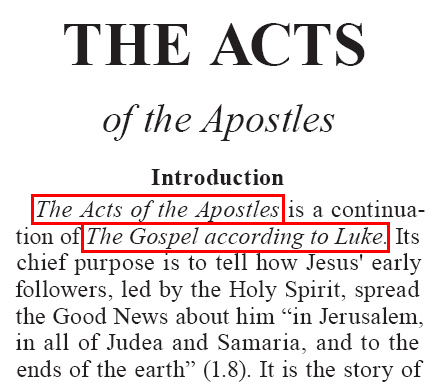
\dc …\dc*¶
- Syntax
\dc_text...\dc*- Type
character
- Added
1.0
- Use
Deuterocanonical/LXX additions or insertions in the Protocanonical text.
\lit¶
- Syntax
\lit_text...- Type
paragraph
- Added
1.0
- Use
Liturgical note/comment. (e.g. a guide which tells the reader/worshipper that he should recite a prayer or recitation etc.)
A paragraph style.
Text and Formatting Sample - Psalm 3 (Russian Synodal, Orthodox Version)
\c 3
\d
\v 1 Псалом Давида, когда он бежал от Авессалома, сына своего.
\p
\v 2 Господи! как умножились враги мои! Многие восстают на меня;
\v 3 многие говорят душе моей: «нет ему спасения в Боге».
\v 4 Но Ты, Господи, щит предо мною, слава моя, и Ты возносишь голову мою.
\v 5 Гласом моим взываю к Господу, и Он слышит меня со святой горы Своей.
\v 6 Ложусь я, сплю и встаю, ибо Господь защищает меня.
\v 7 Не убоюсь тем народа, которые со всех сторон ополчились на меня.
\v 8 Восстань, Господи! спаси меня, Боже мой! ибо Ты поражаешь в ланиту всех врагов
моих; сокрушаешь зубы нечестивых.
\v 9 От Господа спасение. Над народом Твоим благословение Твое.
\lit Слава:
Слава: = “Glory”.
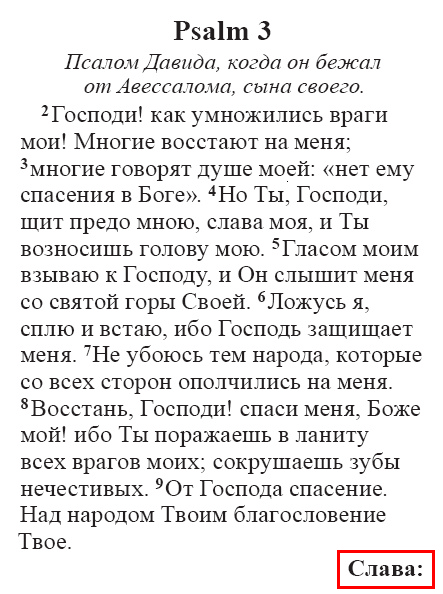
\nd …\nd*¶
- Syntax
\nd_text...\nd*- Type
character
- Added
1.0
- Use
Name of God (name of Deity).
Text and Formatting Sample - Exodus 3.15 (GNT)
\p
\v 14 God said, “I am who I am. You must tell them: ‘The one who is called I AM has
sent me to you.’
\v 15 Tell the Israelites that I, the \nd Lord\nd*, the God of their ancestors, the God
of Abraham, Isaac, and Jacob, have sent you to them. This is my name forever; this is
what all future generations are to call me.
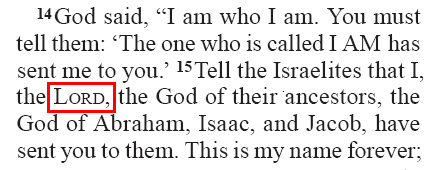
\ord …\ord*¶
- Syntax
\ord_text...\ord*- Type
character
- Added
1.0
- Use
Ordinal number ending (i.e. in “1st” — 1\ord st\ord*).
\qt …\qt*¶
- Syntax
\qt_text...\qt*- Type
character
- Added
1.0
- Use
Quoted text.
Old Testament quotations in the New Testament, or other quotations.
Text and Formatting Samples
Poetic format, where all text is a quotation.
\q1 \qt ........................................\qt*
\q2 \qt ........................................\qt*
\q1 \qt ........................................\qt*
\q2 \qt ........................................\qt*
Poetic format, where text is mixed (only some is a quotation).
\q1 \qt ...............\qt* ..............\qt ........\qt*
\q2 \qt .....\qt* ................................
\q1 ..................................................
\q2 \qt.........................................\qt*
Mark 1.2-3 (GNT)
\p
\v 1 This is the Good News about Jesus Christ, the Son of God.
\v 2 It began as the prophet Isaiah had written:
\q1 \qt “God said, ‘I will send my messenger ahead of you\qt*
\q2 \qt to open the way for you.’\qt*
\q1
\v 3 \qt Someone is shouting in the desert,\qt*
\q2 \qt ‘Get the road ready for the Lord;\qt*
\q2 \qt make a straight path for him to travel!’ ”\qt*
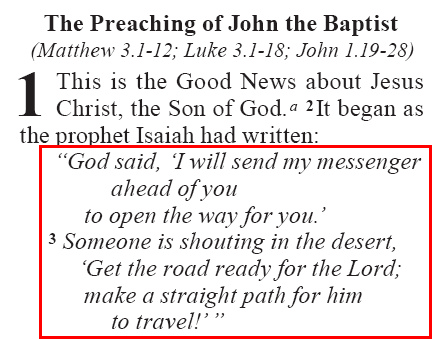
\sig …\sig*¶
- Syntax
\sig_text...\sig*- Type
character
- Added
1.0
- Use
Signature of the author (of a letter or epistle).
Text and Formatting Sample - Colossians 4.18 (GNT)
\p
\v 18 With my own hand I write this: \sig Greetings from Paul\sig*. Do not forget
my chains!
\cls May God's grace be with you.

\sls …\sls*¶
- Syntax
\sls_text...\sls*- Type
character
- Added
1.0
- Use
Passage of text based on a secondary language or alternate text source.
E.g. The French NBS02 has large sections of text in EZR and DAN in italics, to represent where the original text is in Aramaic, not Hebrew.
Text and Formatting Sample - Ezra 4.8—6.18 (NBS - French, Nouvelle Bible Segond)
\v 7 Et aux jours d'Artaxerxès, Bishlam, Mitredath, Tabéel et le reste de leurs
collègues écrivirent à Artaxerxès, roi de Perse. Le texte de la lettre fut écrit en
araméen, traduit en araméen.
\p
\v 8 \sls Rehoum, chancelier, et Shimshaï, secrétaire, écrivirent au roi Artaxerxès
la lettre suivante concernant Jérusalem, savoir:\sls*
\v 9 \sls «Rehoum, chancelier, Shimshaï, secrétaire, et le reste de leurs collègues,
ceux de Dîn, d'Apharsatak, de Tarpel, d'Apharas, d'Erek, de Babylone, de Suse, de Déha,
d'Elam,\sls*
...
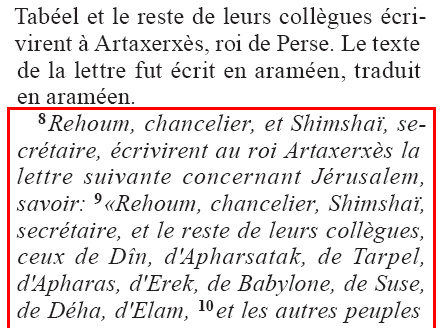
\tl …\tl*¶
- Syntax
\tl_text...\tl*- Type
character
- Added
1.0
- Use
Transliterated (or foreign) word(s).
Text and Formatting Sample - Matthew 27.46 (GNT)
\s1 The Death of Jesus
\r (Mark 15.33-41; Luke 23.44-49; John 19.28-30)
\p
\v 45 At noon the whole country was covered with darkness, which lasted for three hours.
\v 46 At about three o'clock Jesus cried out with a loud shout, \tl “Eli, Eli, lema
sabachthani?”\tl* which means, “My God, my God, why did you abandon me?”

\wj …\wj*¶
- Syntax
\wj_text...\wj*- Type
character
- Added
2.0
- Use
Words of Jesus.
Character Styling¶
Warning
Note: The use of formatting oriented character markup is strongly discouraged. Please search for the appropriate USFM element to markup content, wherever possible.
\no …\no*¶
- Syntax
\no_text...\no*- Type
character
- Added
1.0
- Use
Normal text.
May be used when a larger paragraph element is set in an alternate font style (e.g. italic), and a selected section of text should be displayed in normal text.
\sc …\sc*¶
- Syntax
\sc_text...\sc*- Type
character
- Added
1.0
- Use
Small-cap text.
Spacing and Breaks¶
~¶
- Syntax
~- Type
character
- Added
1.0
- Use
No-break space.
c.f. Unicode character U+00AO (NO-BREAK SPACE)
//¶
- Syntax
//- Type
character
- Added
1.0
- Use
Discretionary (optional) line break.
Primarily used in poetic text, but could also be used for marking optional breaks for titles, headings, or table cell content breaks.
Text and Formatting Sample - Matthew 9.1 (GNT)
\c 9
\s1 Jesus Heals a Man // Who Could Not Walk
\r (Mark 2.1-12; Luke 5.17-26)
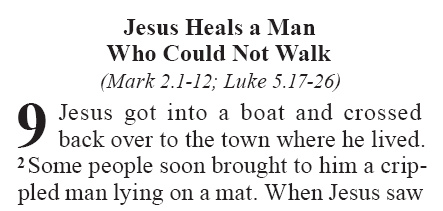
\pb¶
- Syntax
\pb- Type
paragraph
- Added
1.0
- Use
Explicit page break.
Special Features¶
\fig …\fig*¶
- Syntax
\fig_DESC|FILE|SIZE|LOC|COPY|CAP|REF\fig*- Type
paragraph
- Added
1.0
- Use
For defining illustrations to be used within a publication.
A series of parameters for the illustration are provided between the opening and closing\fig ...\fig*markers. Parameters are separated by a vertical bar|.
Required parameters are indicated in the list below with a red asterisk *.- Parameters
DESC – Illustration description. (This material does not show up on the printed page.)
FILE* – Illustration filename.
SIZE* – Illustration relative size. Options arecol(illustration should be inserted inline within the current text column) orspan(illustration should be inserted across (spanning) text columns)
LOC – Illustration location/range. Specify a range of references at which the illustration might be inserted.
COPY – Illustration copyright info. This material will be used to give the appropriate illustration credits.
CAP* – Illustration caption. This text will be printed with the illustration.
REF* – Illustration reference (e.g. Luke 19.5). This text will be printed together with the illustration caption.
Text and Formatting Sample - Spanning Columns - Mark 1.18 (GNT)
\p
\v 16 As Jesus walked along the shore of Lake Galilee, he saw two fishermen, Simon and
his brother Andrew, catching fish with a net.
\v 17 Jesus said to them, “Come with me, and I will teach you to catch people.”
\v 18 At once they left their nets and went with him. \fig |avnt016.tif|span|||At once
they left their nets.|1.18\fig*
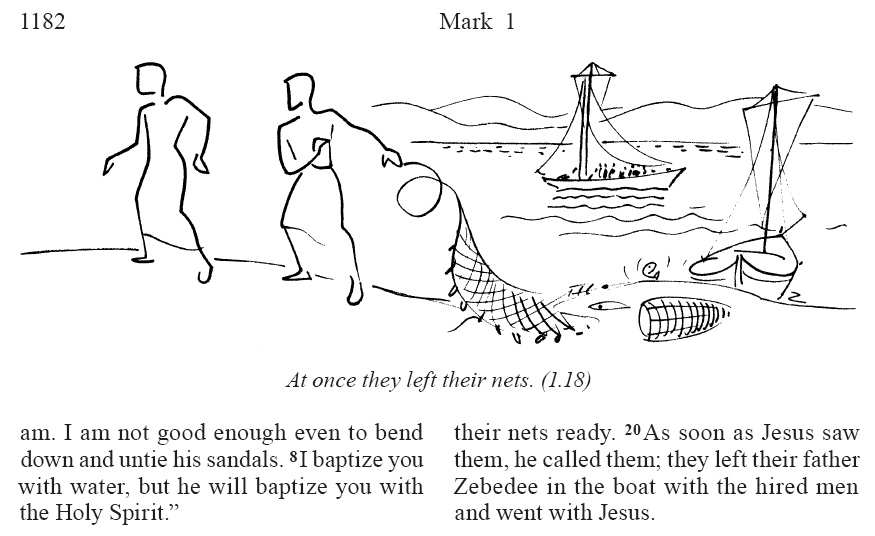
Current Column - Mark 1.31 (GNT)
\v 30 Simon's mother-in-law was sick in bed with a fever, and as soon as Jesus arrived,
he was told about her.
\v 31 He went to her, took her by the hand, and helped her up. The fever left her, and
she began to wait on them. \fig |avnt017.tif|col|||Took her by the hand, and...the fever
left her.|1.31\fig*
\p
\v 32 After the sun had set and evening had come ...
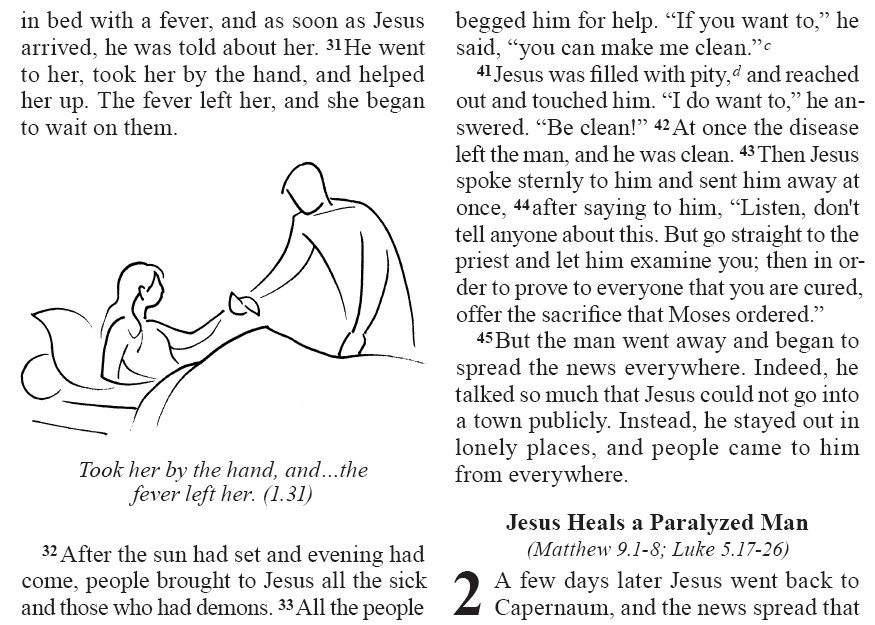
\ndx …\ndx*¶
- Syntax
\ndx_text...\ndx*- Type
character
- Added
1.0
- Use
Subject index entry.
Surround word(s) with this markup to indicate that it appears (or should appear) in the subject index.
\pro …\pro*¶
- Syntax
\pro_text...\pro*- Type
character
- Added
2.0
- Use
Pronunciation information.
Used for CJK text.
\w …\w*¶
- Syntax
\w_text...\w*- Type
character
- Added
1.0
- Use
Wordlist / glossary / dictionary entry.
Surround word(s) with this markup to indicate that it appears (or should appear) in the word list.
\wh …\wh*¶
- Syntax
\wh_text...\wh*- Type
character
- Added
1.0
- Use
Hebrew word list entry.